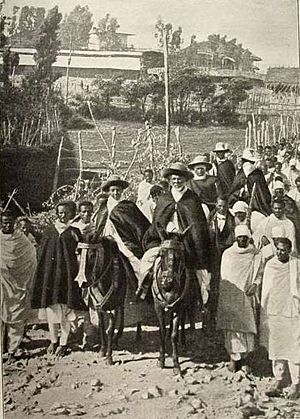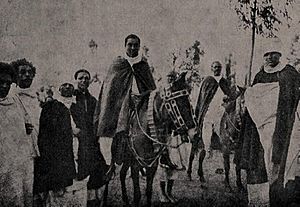Lij Iyasu facts for kids
Quick facts for kids Iyasuኢያሱ |
|||||
|---|---|---|---|---|---|
| Lij | |||||
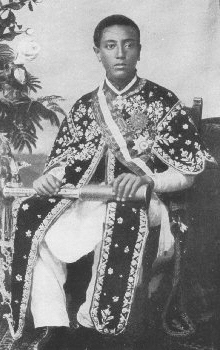 |
|||||
| Emperor-designate of Ethiopia | |||||
| Reign | 12 December 1913 – 27 September 1916 | ||||
| Coronation | Uncrowned | ||||
| Predecessor | Menelik II | ||||
| Successor | Zewditu I | ||||
| Born | 4 February 1895 Dessie, Wollo, Ethiopian Empire |
||||
| Died | 25 November 1935 (aged 40) Addis Ababa, Ethiopian Empire |
||||
| Burial | Compound of St Markos Church | ||||
| Spouse | Seble Wongel Hailu | ||||
|
|||||
| Dynasty | House of Solomon (Shewan Branch) | ||||
| Father | Mikael Ali | ||||
| Mother | Woizero Shewaregga Menelik | ||||
| Religion | Allegations of conversion to Islam caused his excommunication from the Ethiopian Orthodox Church | ||||
Lij Iyasu (Ge'ez: ልጅ ኢያሱ; 4 February 1895 – 25 November 1935) was chosen to be the next Emperor of Ethiopia from 1913 to 1916. His baptismal name was Kifle Yaqob. Ethiopian emperors usually picked their official name when they were crowned. Since Iyasu was never crowned, he is known as Lij Iyasu. The word "Lij" means "child," especially one born into a royal family.
Contents
Early Life and Family Background
Lij Iyasu was born on 4 February 1895 in Dessie, a city in the Wollo province of Ethiopia. His father, Ras Mikael, was a governor of Wollo. He came from a family of Muslim rulers in Wollo and was mostly of Oromo descent. Ras Mikael was born Mohammed Ali and was Muslim until 1875, when he became a Christian.
Iyasu's mother, Woizero ("Lady") Shoaregga, was the oldest daughter of Emperor Menelik II. She was from the Amhara ethnic group in Shewa.
Becoming Emperor
Choosing the Next Leader
As Emperor Menelik II grew older, he faced a big problem: who would rule after him? If he didn't name an heir, Ethiopia might fall into civil war. European countries were also looking to expand their power in Africa.
Menelik had a few possible heirs. He chose his younger grandson, Lij Iyasu, to succeed him. On 15 May 1909, Menelik told his ministers that Iyasu would be the next emperor. However, because Iyasu was still young, Menelik agreed to appoint a Regent to rule until Iyasu was old enough. This regent was an important statesman named Ras Tessema Nadew.
In May 1909, Iyasu married Woizero Romanework Mengesha. She was the daughter of Ras Mengesha Yohannes and the granddaughter of Emperor Yohannes IV. This marriage was later ended. In April 1910, Iyasu married Seble Wengel Hailu, the daughter of Ras Hailu Tekle Haymanot of Gojjam.
Iyasu's Time as Regent
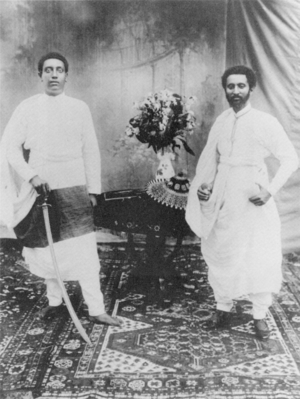
After choosing Iyasu, Emperor Menelik became very ill. He was unable to rule until his death in 1913. During this time, Empress Taitu tried to gain power. She wanted to replace Iyasu with someone else. To stop her, several nobles worked together. On 28 October 1909, Iyasu was publicly named as Menelik's heir, with Ras Tessema Nadew as regent.
The new regent, Tessema, faced challenges. Empress Taitu still tried to control things. Also, Tessema himself became ill. This made it hard for the government to work well. However, Tessema did help keep some order.
Iyasu and Tessema continued Menelik's plans to modernize Ethiopia. They even started the first police force in Addis Ababa. On 10 April 1911, Tessema Nadew died. When the leaders met to choose a new regent, Lij Iyasu said he wanted to be the regent himself. On 11 May, Iyasu's official seal began to be used instead of his grandfather's.
Iyasu faced many challenges early in his rule. Some people tried to overthrow him or even poison him. The government also had money problems. His father, Ras Mikael, often came to Addis Ababa with his army to support his son.
Lij Iyasu often left the capital city. He traveled around the country, meeting with common people. He wanted to show that the government couldn't work without him. He also wanted to be crowned emperor right away.
Once, he had a disagreement with the commander of the Imperial Bodyguard. Iyasu wanted to move into the Imperial Palace, but Empress Taitu refused to leave with the sick Emperor. This led to a tense standoff between Iyasu's soldiers and the Imperial Guard. The Archbishop helped calm the situation. Iyasu was not able to move into the palace then, but he did have the commander of the Imperial Bodyguard sent away from the capital.
Iyasu's Reign as Emperor
Emperor Menelik II died secretly on the night of 12–13 December 1913. Iyasu was told about his grandfather's death. The news was kept quiet for a while. Empress Taitu and Iyasu's aunt, Zewditu Menelik, were moved out of the Imperial Palace. By mid-January 1914, the news became public. The nobles of Ethiopia gathered to discuss the future. They supported Iyasu as Menelik's heir, but they didn't want him to be crowned immediately. They did agree to his idea of crowning his father as "Negus of the North."
Lij Iyasu didn't show much interest in the daily running of the government. He left most of the work to the ministers. These ministers had been in power since his grandfather's time and had a lot of influence. Iyasu often insulted them and said he wanted to replace them with new officials. His ideas for change often clashed with the older ministers' traditional ways.
Iyasu also did some things that upset the nobles. For example, he arranged for his royal cousin to marry his former driver. He also gave a Syrian friend, a rubber merchant, control over customs and taxes at a major railway station. These actions, along with Iyasu's frequent trips away from the capital, made the ministers, led by the Minister of War, Fitawrari Habte Giyorgis, start planning against him.
Rumors of Converting to Islam
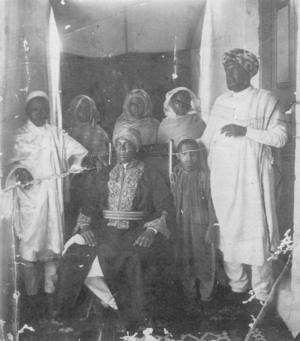
In 1914, Iyasu made Abdullahi Sadiq the governor of Ogaden. This decision was strongly opposed by the British. In February 1915, Iyasu traveled to Harar with Abdullahi Sadiq. He visited the city's largest mosque and spent time with Muslims. This worried the Christian priests in Ethiopia, especially when he stayed in the Muslim community during Easter.
At this time, World War I was happening, and European countries wanted Ethiopia to join their side or stay neutral. There were rumors that Iyasu might join the Central Powers (Germany and the Ottoman Empire). Some reports suggested he was planning to invade Sudan.
In August 1915, Iyasu secretly visited French Somaliland. He had mysterious meetings there. Around the same time, the British reported that messages encouraging a holy war against Europeans were posted in Harar. The Italians also claimed that Iyasu had declared himself a Muslim to Muslim leaders. These reports, whether true or not, made many people very angry with Iyasu. European colonial powers began to support a plan to remove Iyasu from power.
Iyasu's Downfall
On 27 September 1916, while Iyasu was in Harar, he was removed from power. His aunt, Zewditu, was named Empress. The nobles in the capital, led by Fitawrari Habte Giyorgis Dinagde, accused Lij Iyasu of converting to Islam. They said that by doing so, he had lost his right to be emperor.
The Coptic Archbishop agreed to release the nobles from their promise of loyalty to Iyasu. Iyasu was then officially removed from the throne and excommunicated from the Church. The nobles then named Zewditu Menelik as Empress of Ethiopia. Dejazmach Tafari Makonnen was given the title of Ras and made the heir to the throne.
Iyasu sent an army to attack Addis Ababa, but it was defeated. His father, Negus Mikael, marched south with his army but was defeated at the Battle of Segale on 27 October. After this defeat, Iyasu fled towards the Eritrean border. He tried to get support from other nobles and the Italians, but he failed.
Iyasu took refuge on a mountain called Maqdala. He was surrounded by forces loyal to the new government. On 18 July 1917, he escaped and tried to start a rebellion, but his forces were defeated. After this, Iyasu hid in the desert for five years.
On 11 January 1921, Iyasu was captured. He was placed under house arrest by his cousin, Ras Kassa Haile Darge, at his home in Fiche. Empress Zewditu I, despite how Iyasu had treated her, felt sorry for him. She wanted him to return to the Christian faith. She made sure he lived comfortably and had everything he wanted. Ras Kassa also treated Iyasu well during his imprisonment.
Later Years
Empress Zewditu died in 1930, and Haile Selassie became Emperor. Haile Selassie was not as sympathetic to Iyasu. In 1931, Iyasu escaped from Fiche. He was recaptured shortly after. He was then taken to a fortress on Mount Gara Muleta, where he was closely guarded.
When Italy invaded Ethiopia in 1935, Italian planes dropped flyers asking people to rebel against Haile Selassie and support "the true Emperor Iyasu V." There was a fear that the Italians would use Iyasu to weaken Ethiopia's resistance.
In November 1935, Iyasu's death was announced. The exact details of his death and where he was buried are still a mystery. Some rumors say Emperor Haile Selassie ordered his death, while others say he died naturally. His grandson claims Iyasu was secretly buried at the Church of St. Mark in Addis Ababa. Another account suggests he was buried at Debre Libanos monastery.
Family Life
Iyasu had a younger sister named Zenebe Worq, who died young. He also had an older half-sister, Woizero Sehin Mikael. Her daughter, Menen Asfaw, later became the wife of Emperor Haile Selassie. Another half-sister was Woizero Tewabech Mikael.
Through his mother, Iyasu was related to King Solomon and the Queen of Sheba. Through his father, he claimed to be a descendant of Muhammad. Lij Iyasu had several children. His only legitimate child was a daughter named Alem Tsahai Iyasu, born in 1928. Emperor Haile Selassie gave her the title of Emebet-hoy.
What People Thought of Iyasu
The Ethiopian historian Bahru Zewde describes Iyasu's time as ruler as "one of the most puzzling in Ethiopian history."
Some people, like Fitawrari Tekle Hawariat Tekle Mariyam, believed Iyasu was not fit to be emperor. They felt his removal was necessary for Ethiopia's survival. Tekle Hawariat recalled Iyasu visiting a Roman Catholic church and smoking a cigarette during Mass, which was very scandalous for the Ethiopian Orthodox Church.
However, Bahru Zewde also notes that Iyasu made some changes that could be seen as positive. He updated parts of Ethiopia's laws and created a police force. His efforts to include Muslim people in Ethiopia could be seen as trying to make them feel more at home in their own country.
During the reign of his cousin Haile Selassie, Iyasu was often spoken of in very negative ways. Paul B. Henze suggests that Iyasu likely had good intentions but that his actions were often unwise and led to bad results.
Honours
National
Foreign
 Knight Grand Cross of the Order of Leopold (Austro-Hungarian Empire, 1912)
Knight Grand Cross of the Order of Leopold (Austro-Hungarian Empire, 1912) Knight Grand Cross of the Order of the Crown of Italy (Kingdom of Italy, 1912)
Knight Grand Cross of the Order of the Crown of Italy (Kingdom of Italy, 1912) Honorary Knight Grand Cross of the Royal Victorian Order (United Kingdom, 7 September 1911)
Honorary Knight Grand Cross of the Royal Victorian Order (United Kingdom, 7 September 1911)
|
See also
 In Spanish: Iyasu V para niños
In Spanish: Iyasu V para niños


